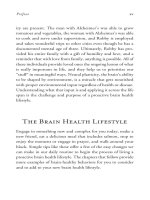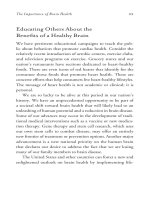Save Your Brain: The 5 Things You Must Do to Keep Your Mind Young and Sharp_3 pot
Bạn đang xem bản rút gọn của tài liệu. Xem và tải ngay bản đầy đủ của tài liệu tại đây (244.09 KB, 15 trang )
Save Your Brain14
4. I eat two meals with utensils daily. 5 points
I eat one meal with utensils daily. 3 points
I do not use utensils on a daily basis. 0 points
5. I eat walnuts or almonds several times a week. 5 points
I eat walnuts once or twice a month. 3 points
I do not eat walnuts. 0 points
6. I consume 80 percent of the portions provided me
as a rule. 5 points
I consume 100 percent of the food on my plate. 3 points
I tend to overeat regardless of portion size. 0 points
Nutritional Domain Total Points Ϭ 30
What Your Score Means
You may use the following guide to interpret your scores:
100–90: Great job! Maintain your lifestyle approach.
89–80: Good job! Make a few changes to improve your
lifestyle.
79–70: Average. Consider making changes in several
domains.
69–60: Poor. Signifi cant change is needed in several
domains.
59–50: Help! Reassess the importance of your life story
and attempt to make one small change in your lifestyle
at a time.
Introduction 15
Do not be concerned if you score poorly at fi rst. This is prob-
ably the fi rst time you have considered your own brain health!
You will notice improvement if you remain loyal to your brain
health lifestyle!
Calculate and Interpret Your Scores
1. To derive your quarterly brain health score for each
domain, add the scores of your circled responses and insert
the total score into the formula listed for each one.
2. To derive your quarterly total brain health score, add the
total scores for each domain, divide by 140, and then mul-
tiply by 100.
3. To derive an annual brain health score by domain
, add the
four scores of each domain and apply that score to the for-
mula listed for the annual brain health score for that par-
ticular domain.
For example, here’s how you would obtain an annual brain
health score for the physical domain:
Total score for each quarter Ϭ 100 ϫ 100 ϭ
4. To derive a grand total for overall brain health for the year:
add the fi ve annual brain health scores together, divide by
560, and multiply by 100:
Grand Total ϭ (five annual brain health scores) Ϭ 560
ϭ ϫ 100 ϭ
Save Your Brain16
Date
SOCIAL
PHYSICAL MENTAL
SPIRITUAL NUTRITIONAL
Baseline
Score
Ϭ 25 ϭ
ϫ 100 ϭ
Ϭ 25 ϭ
ϫ 100 ϭ
Ϭ 35ϭ
ϫ 100 ϭ
Ϭ 25 ϭ
ϫ 100 ϭ
Ϭ 30 ϭ
ϫ 100 ϭ
First
Quarter
Ϭ 25 ϭ
ϫ 100 ϭ
Ϭ 25 ϭ
ϫ 100 ϭ
Ϭ 35ϭ
ϫ 100 ϭ
Ϭ 25 ϭ
ϫ 100 ϭ
Ϭ 30 ϭ
ϫ 100 ϭ
Second
Quarter
Ϭ 25 ϭ
ϫ 100 ϭ
Ϭ 25 ϭ
ϫ 100 ϭ
Ϭ 35ϭ
ϫ 100 ϭ
Ϭ 25 ϭ
ϫ 100 ϭ
Ϭ 30 ϭ
ϫ 100 ϭ
Third
Quarter
Ϭ 25 ϭ
ϫ 100 ϭ
Ϭ 25 ϭ
ϫ 100 ϭ
Ϭ35ϭ
ϫ 100 ϭ
Ϭ 25 ϭ
ϫ 100 ϭ
Ϭ 30 ϭ
ϫ 100 ϭ
Fourth
Quarter
Ϭ 25 ϭ
ϫ 100 ϭ
Ϭ 25 ϭ
ϫ 100 ϭ
Ϭ 35ϭ
ϫ 100 ϭ
Ϭ 25 ϭ
ϫ 100 ϭ
Ϭ 30 ϭ
ϫ 100 ϭ
Annual
Brain
Health
Score
Ϭ 100 ϭ
ϫ 100 ϭ
Ϭ 100 ϭ
ϫ 100 ϭ
Ϭ 140 ϭ
ϫ 100 ϭ
Ϭ 100 ϭ
ϫ 100 ϭ
Ϭ 120 ϭ
ϫ 100 ϭ
17
1
The Importance
of Brain Health
Brain health and indeed the human brain is now securely positioned on
the radar screen of the American psyche.
7
T
he belief that a proactive approach can help to reduce the
risk of brain disease is the core principle of the brain health
movement. While the focus of this book and my career is brain
health, there remains a need to understand the consequences of
brain disease. It is from this understanding of the devastation
caused by brain disease that a strong energy to learn about and
implement brain health emerges, not out of fear, but out of a
motivation to build and preserve access to our own life story.
When thinking about brain health, we often think about
brain disease. This makes sense, as disease in general has tradi-
tionally been the focus of our medical training and approach to
health care. “Brain disease” refers to an array of conditions that
negatively affect the function of the brain. Examples range from
progressive neurodegenerative diseases, such as Alzheimer’s,
Save Your Brain18
Parkinson’s, and Lewy body dementia, to mental illnesses, such
as depression, anxiety, bipolar disorder, schizophrenia, perva-
sive developmental disorders, and substance abuse, to trauma,
such as closed head injury. Each of these conditions, and hun-
dreds of others, impacts the structure and function of the brain,
resulting in cognitive, emotional, and functional decline for the
person. Such conditions and diseases also result in signifi cant
disruption of the family system and place a tremendous emo-
tional and practical toll on the caregiver. Because the brain is
so complex and we know so little about it, our interventions
are symptom-based, not curative. When considering the brain,
we tend to rely on the medical approach to the human brain
that overly emphasizes disease, but we should strive to take on
another perspective with an eye toward brain health, develop-
ment, and growth rather than relying on reactive, quick, and
invasive procedures only. Brain health is proactive and lifelong,
with nothing quick about it. It’s a lifestyle.
For many years we have believed that the brain is a fi xed
and rigid entity that has a limited window of opportunity to
develop, the “critical period of brain development.” Traditional
thinking taught us that this critical period occurred early in
life and new skill development could not happen beyond that
time. Similarly, the ideas that brain disease is inevitable with
advanced age and that once the brain is damaged it cannot
be treated or healed were generally accepted. With our new
understanding of the human brain, we have begun to challenge
these ideas, and the new concept of brain health maintains that
a proactive approach can be implemented at the earliest period
of life and followed across the entire life span. Brain health
The Importance of Brain Health 19
further maintains the belief that we can shape our brains for
health by exposing ourselves to a specifi c type of environment
and by engaging in specifi c activities as often as possible.
Defining Dementia
Dementia is a clinical condition characterized by decline in
overall intelligence relative to premorbid intellect, memory loss,
personality change, and functional loss. There are nearly one
hundred causes of dementia, and 95 percent of the causes of
dementia are irreversible. Examples of the causes of dementia
include Alzheimer’s, Parkinson’s, substance abuse, tumor, head
injury, multiple strokes, and Lewy body. Most, though not all,
types of dementia manifest in later life beyond age sixty-fi ve.
Examples of reversible causes of dementia include thyroid disor-
der, vitamin defi ciency such as B
12
defi ciency, and depression.
Alzheimer’s disease is a progressive neurodegenerative dis-
order, the number one cause of dementia in the United States,
accounting for 50 to 70 percent of all dementias, and is often
used as the model of brain disease. The disease strikes specifi c
regions of the brain and manifests in a predictable pattern of
forgetfulness, loss of appreciation of space, personality change,
and other defi cits in thinking and function.
As a progressive disease, the course of Alzheimer’s lasts on
average ten or more years and cannot be reversed. Unfortu-
nately, this horrifi c disease is the leading cause of dementia in
the United States, presently affecting nearly fi ve million per-
Save Your Brain20
sons, and is a major cause of dementia internationally. The
number of Alzheimer’s cases in the United States will increase
to a staggering fi fteen million or more by the middle of this cen-
tury. Indeed, the United States presently spends over one hun-
dred billion dollars annually on direct care of Alzheimer’s, and
corporate America loses over thirty billion dollars annually, as
the employees, who are also caregivers of parents or loved ones
with Alzheimer’s or dementia, miss work and develop physical
and mental illness themselves.
Alzheimer’s disease is a deeply personal catastrophe that
robs a family of their personal connection. For me, the ulti-
mate question is, what is the dollar amount for the fact that
somebody’s father or grandmother has not been able to com-
municate with his or her grandchild during the past decade?
The essence of this question drives the motivation for my
work in the area of brain health. There can be no greater loss
than the inability to connect with one’s own identity and fur-
ther connect with the loved ones in our lives. It is the precise
reality of the husband who entered my offi ce so many years ago
in a deep depression because he could no longer connect with
his wife, who was suffering from dementia, and wanted her
back with him.
Alzheimer’s and other brain diseases are a fact of life and an
unfortunate reality for too many families. Brain disease, like
brain health, does not discriminate; it unites us in a common
cause regardless of background. Our energy and resources are
committed to fi nding cures for these diseases, but our incom-
plete understanding of the human brain most likely means a
cure for dementia is not near. However, we can and should
The Importance of Brain Health 21
consider the behaviors and activities that relate to brain health
as a viable and necessary path to follow now to forestall or
reduce the risk of brain disease.
Degenerative and Other Types
of Memory Loss
Brain dysfunction and disease can be caused in many ways. We
have discussed dementia as a description of predominantly pro-
gressive forms of brain dysfunction. However, there are many
other etiologies for brain dysfunction that may not be irrevers-
ible. In human brain function, so many processes need to be
in balance or atypical or abnormal thinking and behavior can
result. As a clinician, I have seen cognitive or thinking problems
result from high and low blood pressure, urinary tract infec-
tion, medication side effect, lack of sleep, too much coffee or
other stimulant, anxiety, stress, hormonal imbalance, and sugar
imbalance. These and other everyday occurrences can affect a
person’s thinking and mood regardless of age.
It is quite common for a person in his or her fi fties to begin
noticing problems with memory or an inability to fi nd an appro-
priate word or name as easily as in the past. For some, this may
be alarming and suggest onset of a disease such as Alzheimer’s.
Indeed, I am often asked if I believe this represents Alzheimer’s.
In most cases, such slips of the tongue, temporary forgetfulness,
or misplacement of objects are not disease-based. Rather, these
Save Your Brain22
cognitive hiccups most likely refl ect stress caused by trying to
do too much all at once, hormonal changes that occur naturally
around the fi fties, and perhaps mood fl uctuations related to
changes in life circumstances. But to remove any question or
doubt about the severity of the problem, I recommend doing a
neuropsychological assessment at any respected academic medi-
cal center.
You can always have an annual neuropsychological exami-
nation beginning in the middle fi fties to monitor your memory
and other cognitive functions, but dementia is quite rare at
this age. The diagnosis that one does not have a degenerative
dementia is good news, but it does not help with the fact that
memory problems can still be frustrating. It is important to
speak to your doctor about change-of-life issues, as hormonal
imbalance is real, and it can cause both mood and memory
problems. And it is not only those in their mid-forties and fi f-
ties who understand the power of hormonal changes. Teenage
brains are notorious for distractibility, inattention, impulsivity,
and downright “goofi ness.” Hormonal changes are a fact of the
teenage brain and underlie the behavioral and cognitive changes
that also can be seen at this time of life.
You can also take a personal assessment of your stress level
and be honest with the idea that you may be doing too much
and going too fast. Stress increases hormonal activity that can
be damaging to the structural and functional capacity of the
brain, particularly if the stress is severe and sustained. Animal
studies demonstrate that chronic stress and overstimulation
cause brain dysfunction and structural changes in the hip-
pocampus (see Chapter 2), the part of the brain critical to new
The Importance of Brain Health 23
learning. On a more moderate level, stress can cause depres-
sion and anxiety, both of which alter our neurochemistry and
can interfere with information processing. You should also take
note of how much sleep you are getting a night. Brain functions
can be affected by your sleeping patterns. Without deep sleep
and dream sleep, otherwise known as REM (rapid eye move-
ment) sleep, the brain will not process information effi ciently.
Increased stress and reduced rest can certainly result in cogni-
tive mistakes, forgetfulness, mood disorder, and frustration.
Changes occur to all parts of our body as we get older, and
the brain is certainly not excluded from this reality. The main
message of this book is to know about your brain and to care
for it for life. Hopefully, the care begins well before age fi fty-
fi ve, but no age is too late to start. Lifestyle modifi cation can
be very helpful to easing the mental lapses, dysnomia (inability
to name things), and misplacement of objects. You will fi nd
that writing things down can be an effective strategy for your
recall. By writing things down, we provide cues and prompts
that help our brains to more easily locate the information to be
retrieved. The reason is that with healthy aging, the hippocam-
pus continues to encode information fi ne. Our brains simply
have more diffi culty retrieving information, and we therefore
can benefi t from cues that get us to the material our brain has
already encoded. Writing things down turns a free recall task
into a more simple recognition memory task.
This type of normal memory change is quite different from
disease such as Alzheimer’s, which prevents the brain from
encoding new information and in which cues will not provide
any benefi t. That is because dementia caused by Alzheimer’s
Save Your Brain24
erodes the hippocampus, the encoding system for the brain,
while changes typical of advanced age alone do not. Indeed
studies have shown that healthy seventy- and eighty-year-old
persons will perform as well as thirty-year-old persons on tests
of recognition memory. One cannot recognize something unless
it has been encoded, which requires a healthy hippocampus.
Raising Awareness for
Brain Health
The human brain has always been a mysterious, misunder-
stood, and neglected part of the human being. Study and
interest in the brain has generally taken a traditional academic
approach that does not permit personalization or consumption
by the general public. This is a major problem for those of us
who believe all humans need to understand the basics of their
brain to achieve success with promoting brain health. With the
advent of new, more sensitive neuroimaging technology, our
understanding of the human brain has increased and changed.
We now know the human brain has “plasticity,” which means it
is dynamic, constantly reorganizing, and malleable—capable of
being shaped structurally and functionally by the environment.
This deviates from our traditional view of the human brain as a
rigid and fi xed system not capable of developing much beyond
childhood.
The Importance of Brain Health 25
It is this new thinking about the human brain that permits a
new applied practice for health in both the personal and societal
approach to the brain. A brain that can be shaped by environ-
ment can be shaped for health and health promotion across the
life span. The key is to learn and apply those behaviors or activi-
ties that maximize brain health on a personal level. In addition,
major sectors of society, including education, business, health
care, religion, and nutrition, have begun to integrate our new
understanding of the human brain into their particular activity
for the consumer.
In order to raise awareness for brain health, grocery stores
could begin labeling their products with brain icons for foods
that are known to promote brain health, and the same is true
for our restaurants. Schools could plan curricula on the human
brain at the earliest of ages, and Head Start and baby well-
ness programs should be enriched with brain health informa-
tion. Corporations could include brain health as part of every
employee orientation and wellness program, and our nation’s
prevention and wellness programs need to include brain health.
It is from the personal and larger societal recognition of new
brain research that a not-so-quiet revolution on brain health has
emerged in the United States and internationally.
Today more of the general public is interested in the human
brain, how it operates, and how it can be shaped for health. The
human brain is no longer the domain of academia or medi-
cine. Indeed, the general public has now taken some ownership
of this part of their body, and there is great excitement and
motivation to learn about what behaviors can help to shape
Save Your Brain26
a healthy brain. As the general public gets more involved in
learning about the human brain, people are understanding that
health of the brain is a very personal issue. This is particularly
true when we consider that our brain contains our life story and
that a signifi cant concern for baby boomers is the loss of our
memory (life story) as we get older. Brain health is no longer
a technical or academic story. Rather, the general public has
made it a highly personal priority to be integrated into daily
lifestyle for health.
The human brain contains our very identity, catalog of
memories, ability to communicate, and life story. A cruel real-
ity is that brain disease can rob the brain of one’s life story and
even disconnect one’s own identity and relationships with fam-
ily members. It is from this personal devastation that a dedica-
tion to promotion of brain health becomes paramount. Indeed,
a lifelong and proactive pursuit of brain health is critical to
each person, because everyone has a life story that needs to
be shared. My work and this book are dedicated to educating
each person on the basics of his or her brain and to promoting
a brain health lifestyle that can help maximize access to one’s
life story at any age.
We are indeed undergoing a not-so-quiet revolution about
the human brain and brain health. The concept of brain health
is now discussed in major sectors of society, including personal
development, health care, business, media, and even religion.
It is quite common to see information on brain health in major
news outlets, popular magazines, peer-reviewed medical jour-
nals, business periodicals, new business start-ups that apply
The Importance of Brain Health 27
product and educational information on brain health to the
general public, retail, and even television programming. This
is good news because it indicates a cultural shift in which the
United States and other nations are prepared and willing to
begin the process of integrating brain health into our language
and, more important, into our daily health regimen.
Personalizing Brain Health
One of the great paradoxes of our time is the fact that the
human brain is the single greatest, most magnifi cent system
ever designed in the history of the universe! Simultaneously,
most Americans do not know the basics of their own brain,
and they cannot be expected to take care of their brain. The
same is most likely true of nearly everyone around the world. A
2006 survey of Americans on brain health sponsored by MetLife
Foundation and the American Society on Aging (asaging
.org) found only 3 percent identifi ed brain health as a leading
health topic. More promising, the same survey found a majority
(88 percent) believe they can keep their brains fi t, and nearly 90
percent believe regular checkups for their brain are important.
Americans also demonstrate a decent understanding of what
activities are considered good for brain health. In order for our
nation and nations around the globe to be enlightened about
brain health, we need to do a better job educating all citizens
about the human brain, and I believe this education should begin
early in life. The story of your brain needs to be a personal one!
Save Your Brain28
As one example of health promotion that is personal, the
United States has done a good job educating the public about
the importance of cardiac, or heart, health. We decided to pri-
oritize heart health because many of our loved ones have cardiac
illness, and cardiac illness represents a primary cause of death.
Interestingly, over the past decade, research indicates that while
cardiac illness remains a leading cause of death, inroads have
been made to slow the rate of cardiac-caused premature death.
Our culture has also adopted a great awareness and, in some
sense, a fondness for the heart as a favorite organ in our body.
Like the ancient Egyptians, we have a belief that our being
revolves around the heart. Our language contains many state-
ments that give the heart meaning it really does not deserve.
For example, statements such as “I love you with all my heart,”
“the Steelers played their hearts out,” and “you broke my
heart” suggest our heart has the capacity for emotion or feel-
ings. Indeed, the human heart is a pump that perfuses blood
throughout the body. It has no capacity to feel emotions like
love, have thoughts, or direct motor skills. All of the emotions
and thoughts that we relate to the heart are really owned by the
brain. In this regard, our brains have not been treated fairly, and
I believe it is time we begin to show our brain a little love and
the attention it deserves. Similar to the sense of urgency we feel
about cardiac health because we lose so many of our loved ones
prematurely due to heart disease, we must be vigilant to the fact
that we are also losing many of our loved ones to Alzheimer’s,
stroke, Parkinson’s, and other diseases of the brain.









